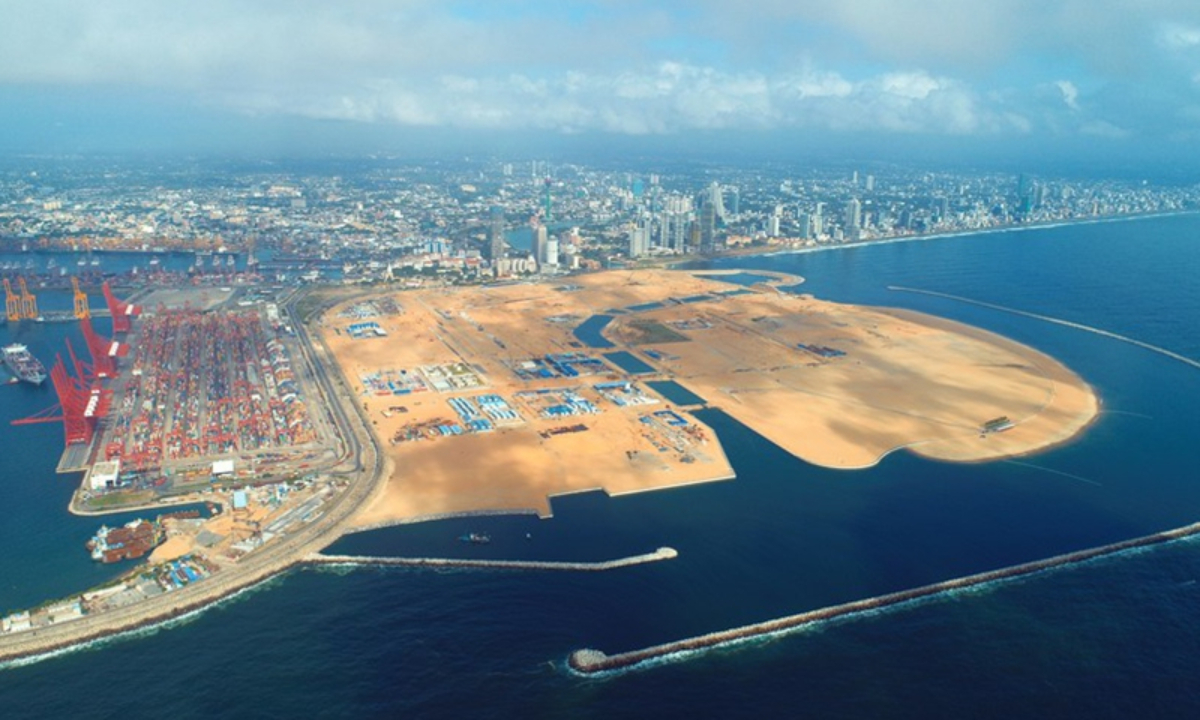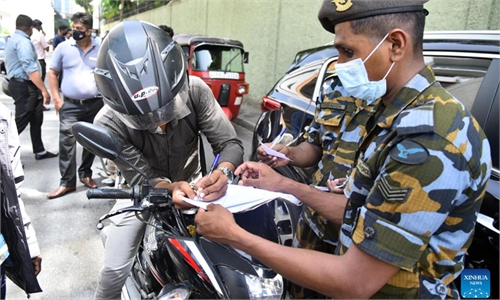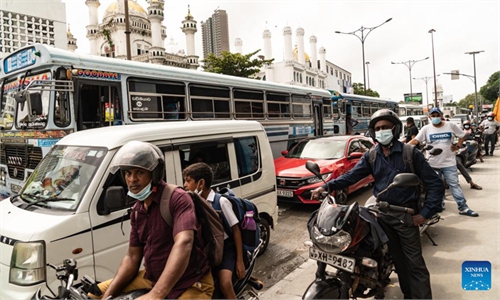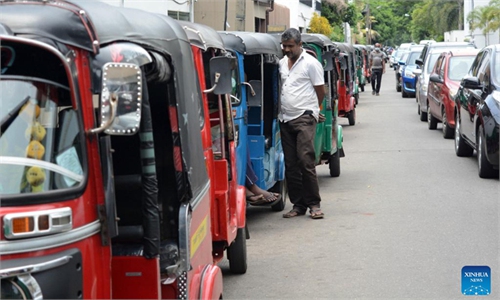
A view of the construction site of the Colombo Port City in Colombo, Sri Lanka Photo: Xinhua
The global inflationary crisis in 2021 and more dramatically in 2022 triggered a Sri Lankan default on payment of $78 million in matured foreign bonds in April 2022. On May 18, the Central Bank of Sri Lanka declared that the country was in a preemptive default status. Political unrest followed as the government failed to provide fuel and imported food, prices have dramatically increased while the government's ability to provide foreign currency to support continued imports dried up.
The Western and components of the Indian mainstream media, think tanks and research centers, and even many government officials have made the Sri Lankan Hambantota Port a globally known name and the main example of "China's debt trap diplomacy," although this was entirely proven to be a false story. As our own research and interviews with experts will show here, the entire story of China being the source of Sri Lanka's debt is fake through and through.
Who own's Sri Lanka's External Debt? Two essential facts are ignored when the media in the West deal with the external debt of Sri Lank: the composition of the debt, and the real causes of the debt. Exactly as in the case of Pakistan, China's share of the external public debt of Sri Lanka is only 10 percent. Western financial institutions, including the private credit markets, and their ally, Japan, hold the lion's share of the debt.
According to the Sri Lankan Department of Foreign Resources, the composition in percentage terms of the foreign debt of Sri Lanka in April 2021 was as follows:
International capital market borrowing 47 percent, Asian Development Bank 13 percent, China 10 percent, Japan 10 percent, World Bank 9 percent, India 2 percent, and others 9 percent.
Thus, a simple look at the facts that usually ignored or blacked out shows that China is not what is being portrayed to be. The real culprits, as shown here in this article, are from the same Western countries, in which the "China debt trap" narrative was concocted.
First, borrowing in international capital markets: After a devastating civil war ending in 2009, the government resorted to expensive borrowing from international bond markets for the reconstruction process. These sovereign loans, from mostly Western financial investors like American BlackRock and British Ashmore constitute the greatest part of the external debt of the country (47 percent). It was the scramble to repay some of this debt, that matured in 2017, that pushed the Sri Lankan government to offer the Hambantota Port for lease. China accepted the offer in return for $790 million that was used to repay the debt to the international markets, not to China.
The bond market is a brutal, profit-seeking force that has a secondary market where investors sell the sovereign debt of troubled countries to so-called "vulture funds" that buy the debt with big discount from the investors to later demand full payment from the debtor nations. Repayments must be made on time, otherwise the country will be shut down from lending. The vulture funds sue sovereign debtors in UK and US courts where, under the threat of seizing the assets of those nations abroad, the courts usually judge in favor of these vulture funds.
Second, the trade deficit: Sri Lanka has a major dependency on imports of oil and gas and their refined products for transport and power generation. In recent years, the global prices have increased but in 2021-2022 skyrocketed. These items, in addition to fertilizers, constitute the most part of the imports of the country. In 2020, total exports were $10 billion, while imports stood at $16 billion ($6 billion deficit). In 2021, the deficit increased to $8 billion as exports amounted to $12 billion and imports $20 billion. Consequently, the current account deficit widened significantly to 4 percent of the GDP in 2021, compared to 1.5 percent of GDP registered in 2020.
Third, collapse of tourism sector: According to the Sri Lankan Tourism Authority, earnings from tourism have been the major contributor to the surplus in the services account for many years. The income, in foreign currency, and level of employment were substantial until their collapse.
First, the Easter terror attack by suicide bombers in April 2019 was a major setback for the tourism sector. A second disaster hit with the 2020 outbreak of the COVID-19 pandemic, which reduced the number of tourists visiting the country to a trickle.
A look at the numbers gives a clear picture. Foreign tourism income reached $3.9 billion in 2017, $4.4 billion in 2018, $3.6 billion in 2019, $682 million in 2020, and $507 million in 2021.
The government supported the industry by compensating for the losses and avoids social and political unrest. The price the government paid was that borrowing increased internally and externally. It is important to note that the tourism sector has a large share of the labor force of Sri Lanka of 8 million workers (total population is 20 million).
Fourth, decline of remittances: Over the past two decades, annual remittances from Sri Lankan nationals abroad have represented nearly one-fourth of total credits to the external current account, on average, and exceptionally, this share exceeded more than one-third (35 percent) in 2020. The remittances declined from $7 billion in 2020 to $5 billion in 2021.
The government of Sri Lanka has been plagued by persistent fiscal deficits for decades, compelling the government to continually borrow from both domestic and foreign markets and in doing so accumulate public debt. As a result, a large fraction of government revenue and foreign currency inflows to the country are required for debt service payments, permitting little leeway for productive investments.
Increasing the productivity of the Sri Lankan economy represents the key solution. But this requires great investments in infrastructure, industrialization, and the modernization of the agricultural sector. Finding alternatives for the very expensive imports of petroleum products is one other very important element of the solution for Sri Lanka.
China does not have a magical wand to change the conditions of nations. The reason China managed to eliminate extreme poverty and build the world's most productive economy is through hard work and massive investments in infrastructure and labor force through education.
China's role in Sri Lanka is considered positive since it focuses on developing the productive aspects of the economy such as modernizing the infrastructure. Contrary to the "debt trap" narrative, China is not Sri Lanka's largest creditor, but rather it is the largest foreign direct investor in the country. China's investments in Sri Lanka are long-term projects that gradually increase the productivity of the economy. But they do not represent a quick fix.
What is needed from the US and Europe, rather than pushing the thoroughly debunked "debt trap" narrative against China, is to join hands with China and the Belt and Road Initiative to assist in rapidly raising the productive capabilities of Sri Lanka through investments and long-term, low interest credits for infrastructure projects, industries, and modern agricultural production.
The author is vice president of the Belt and Road Institute in Sweden. bizopinion@globaltimes.com.cn



